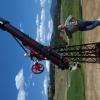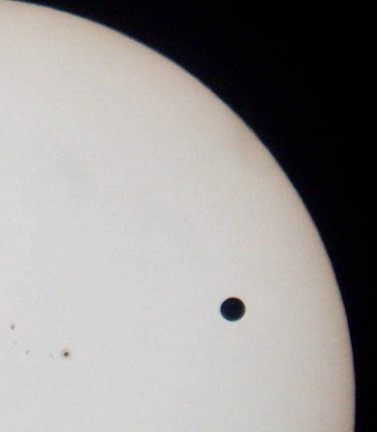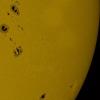
eyepiece / focuser standards
#1

Posted 16 February 2013 - 03:07 AM
Currently there are 0.965", 1.25", 2" and 2.7" focusers along with some newer 3.5" and 4".
Asking if we really need so many? ES is currently proposing a 3" barrel for their new 30mm eyepiece. Adding the 3" gives us 7 standards.
Do we really need this many?
So, how many should we have?
2.7" and 3" seem rather redundant as does 3.5" and 4"
I would suggest 1.25", 2", 3" and 4"
If somehow the community could get together and ask manufacturers to also get together and agree on a standard, there would be no need for many odd sizes and all kinds of adaptors.
Your thoughts please?
#2

Posted 16 February 2013 - 03:31 AM
#3

Posted 16 February 2013 - 04:03 AM
If its possible to have a 16mm 100 degree to fit in a 1.25" barrel size, it would not make much sense to get one in a 3" barrel size where larger size lenses may be used. A 75mm 100 degree eyepiece would need a 5" barrel size.
What all factors would contribute to having larger diameter lenses? AFOV and focal length of the eyepiece? Focal ratio and light cone angle of the primary? These question hve been playing on my mind too for a while..
Clear Skies!
#4

Posted 16 February 2013 - 04:49 AM
I would suggest 1.25", 2", 3" and 4"
In my view, focusers larger than 2 inch are really for photography and not much else. I see no issue with having a variety of sizes that are optimized for a particular telescope. If the scope is capable of a 88mm image circle, then a 4 inch focuser is appropriate. If it is capable of a 50 mm image circle then a smaller diameter drawtube that is optimized for the particular telescope will probably allow for better baffle design.
I don't foresee 3 inch eyepieces as something more niche market. Well corrected 3 inch eyepieces Widefields that require a field stop larger than 42mm are going to be much heavier and bulkier than the 2 inch eyepieces they are replacing. The market for such eyepieces is to increase the field of view over existing eyepieces. These are going to be expensive and to be useful in the scopes where they are most applicable, visual field flatteners and coma corrector are a requirement.
Jon
#5

Posted 16 February 2013 - 08:34 AM
+1Why do you feel the need to standardize focuser sizes?
#6

Posted 16 February 2013 - 08:40 AM
Focusers come in different sizes to allow wide field light cones through without vignetting for photography. To standardize focusers you would also have to standardize the sizes of scopes. That is very unlikely.
No matter what the focuser drawtube size is, all can be or are fitted with standard 2" eyepiece holders for visual use.
There are not so many different sizes in eyepieces.
The recent addition of a 3" size by ES is not going to be for everyone. It is not a good fit for a fast Newt or an SCT. It will work well in some larger refractors but it is expensive, it requires a 3" diagonal and possibly a custom adapter to fit the focuser. Those who have a scope that the 3" can be used with are typically well invested into photography. Often they have other scopes for visual use that use the ususal 2" eyepieces. Of course there are exceptions and that is the niche market that Jon has referred to.
It is unlikely that anyone would outfit an inexpensive mass produced scope for 3" eyepieces. The price of a large focuser, 3" diagonal and an eyepiece will exceed the cost of the scope many times over.
The 3" eyepiece will remain in the class of the observatory scope. Everyman's eyepieces will remain at 1.25" and 2". That's not so many sizes.
dan
#7

Posted 16 February 2013 - 10:15 AM
The reason that it will never happen is the same reason that we don't standardize car tires. Cars (and the requirements for their tire capabilities) differ.
A C5 is optimized for a 1.25" eyepeice. To use it with a 2" eyepeice means that you turn your C5 from f/10 to maybe f/10.5 or even f/11. So not all scopes can benefit from a 2" eyepiece.
Likewise, even some larger SCTs won't be able to use a 3" eyepices because of field illumination (the C8 has a field that is only well illuminated over a 38mm circle and the new 30mm eyepiece allows a 52mm field stop).
But even many refractor will likely not work with a 52mm field stop because the focuser baffle will not allow full illumination.
But just like with car tires, consumers like having a choice.
And just like with cars, one wheel size simply isn't practical.
You can bring it up in a year or two years, or five years, but until we standardize on a specific telescope design, it doesn't make sense to have a standardized eyepiece size.
#8

Posted 16 February 2013 - 11:12 PM
#9

Posted 17 February 2013 - 06:19 AM
And ultimately, those 2.5" focusers or 3.5" focusers are all designed just to be able to make the best use of the same 2" eyepieces or cameras that one might use with an SCT or reflector.
It seems to me that when one looks at the size of the illuminated field of view, refractors are generally have larger illuminated fields of view than Newtonians and SCTs/Cats. The difference between refractors and other designs is that there are no optical compromises necessary to use a 3 inch or 4 inch focuser on a refractor.
Jon
#10

Posted 17 February 2013 - 11:15 AM
You can bring it up in a year or two years, or five years, but until we standardize on a specific telescope design, it doesn't make sense to have a standardized eyepiece size.
Hmm. I'm having trouble making sense of this statement Eddgie.
The reason for standardization is so these eyepieces can be used by many people with many scopes. Everyone has been using the standardized 1.25" and 2" eyepieces for years and years and those eyeieces fit many different kinds and sizes of scopes. I cannot imagine having to buy eyepieces specific to every scope I have in different sizes, and then every time I buy a new scope having to buy an entirely new set of eyepieces, adapters, binoviewers, etc. This seems so completely obvious that i can only hope that I have misinterpreted your original statement Eddgie.
If you meant it doesn't make sense having ONE eyepiece size then we are in complete agreement.
#11

Posted 17 February 2013 - 01:11 PM
I posted this subject about a year ago and thought to bring it up again. The "standardization" of eyepiece barrels and focusers.
Currently there are 0.965", 1.25", 2" and 2.7" focusers along with some newer 3.5" and 4".
Asking if we really need so many? ES is currently proposing a 3" barrel for their new 30mm eyepiece. Adding the 3" gives us 7 standards.
Do we really need this many?
So, how many should we have?
2.7" and 3" seem rather redundant as does 3.5" and 4"
I would suggest 1.25", 2", 3" and 4"
If somehow the community could get together and ask manufacturers to also get together and agree on a standard, there would be no need for many odd sizes and all kinds of adaptors.
Your thoughts please?
I responded above in this thread but having reread your post it seems you have missed what is really happening.
There are minimal eyepiece standards, 0.965, 1.25, and 2. Yes ES has a 3" in the works but it is far from common use.
There are a few odd spotting scopes with unique eyepieces but these are realy quite rare. There are three "standard" eyepiece sizes.
The focusers that these eyepieces will fit in are really quite varied and rightly so. Although the focuser sizes you have shown are valid there are a number of other focuser sizes I have seen. The focuser tube needs to be bigger than the eyepiece barrel to let in a wide light cone. I have 1.375, 1.5, 1.6 that are all fitted with 1.25" eyepiece holders. I don't know the size of the focuser on my Skywatcher but is is some oddball size that has a 2" eyepiece holder. Likewise the Intes crayford I have and the Orion Crayford from an ED80. I have had various Meade focusers that were a size unque to Meade and I am sure there are many others out there. So add a bunch of dufferent sizes to your list, 2.125, 2.25, 2.375, 56m, 2.6" etc, etc.
There are common focuser sizes but there is no standard and nor should there be.
dan
#12

Posted 17 February 2013 - 07:06 PM
Best,
#13

Posted 18 February 2013 - 09:59 AM
There are common focuser sizes but there is no standard and nor should there be.
Dan:
The distinction you make between the eyepiece size and the internal diameter of the drawtube is an important one, particularly for a refractor. The size of the illuminated field depends on the length of the drawtube and the diameter of the drawtube as well as any baffling.
The Takahashi 106 FSQ has a 4 inch focuser because it illuminates an 88mm diameter circle..
In terms of eyepiece standards rather than focuser standards, I think 3 and 4 inch have long been standards, just not very popular standards. Given the necessary accessories (coma corrector, 3 inch diagonal) required to make an eyepiece like this ES 30 mm 100 degree eyepiece practical for those reaching for the widest possible true fields of view, it seems likely to me that the 3 inch eyepiece standard will remain uncommon.
Jon
#14

Posted 18 February 2013 - 07:30 PM
Hmm. I'm having trouble making sense of this statement Eddgie.
What I was inferring was that as long as there are so many telescopes with such different design limits or capbilites, we will need eyepeices with different barrel sizes.
The only way that would change is if everyone used the exact same telescope and that telescope were optimized for a specific eyepiece barrel size.
There are so many telescopes with so many capabilities, there will always need to be a variety of eyepiece sizes.
I don't use 2" eyepieces in my C5 because there is little point to it. The 28mm baffle makes the scope work best with a 1.25" eyepiece.
So, I need 1.25" eyepieces on the market.
My C14 works fine with a 2" eyepiece, but could not really work well with a 3" eyepiece.
My 6" APO though has a 3" focuser and could probably work with a 3" eyepiece, but what happens when I only need a 5mm focal length eyepiece? I go to a 1.25" eyepiece in a 2" to 1.25 inch adapter because most 5mm eyepieces are 1.25".
But since most 5mm eyepieces are 1.25", I would need a 3" to 1.25" and a 3" to 2" adapter for refractor.
People with C5s though would not want to use a 3" visual back and 3" diagonal on their scopes, would they?
So, as long as telescopes come in the variety of sizes and shapes that they do today, we will continue to have different eyepiece barrel sizes, and there is no point asking the question again until that changes. That was my point.
#15

Posted 18 February 2013 - 10:30 PM
AAA, AA, A, B, C, D, 9V batteries all became standardized during WWII and made it very efficient for toy makers, music playes, and customers.
Standardized tires would make it easier also, but OEMs & tire manufactures resists.
For whatever reason watch battery makers also resist, and don't know why. With hundreds of batteries, it makes it diffucult to stock all of them.
#16

Posted 19 February 2013 - 11:34 AM
...
Asking if we really need so many? ES is currently proposing a 3" barrel for their new 30mm eyepiece. Adding the 3" gives us 7 standards.
...
Siebert already offer 3" optics - five different 3" EPs and a 3" diagonal.





















